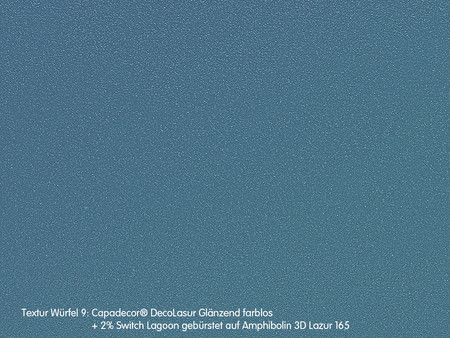Alea iacta est – The Die is Cast
…or why no two blues are the same
We are in 2015 A.D. All cubes are decorated with blue surfaces... All the cubes? Yes! A department staffed by unconditionally creative people does not stop trying out the colour 3D Lazur 165 using all kinds of surface technologies and products. You'd be surprised how the same blue changes.
The product composition and factors such as ambient colour, lighting, gloss level, and surface structure influence the assessment of the colour. In addition, there is the individual colour perception of the individual.
Whether painted, applied with a spatula or glazed, tools in combination with various paints or fillers leave their individual traces.
Although 3D Lazur 165 is the colour reference, the interplay of light and shadow, matt and gloss gives the colour shade a play of varying brilliance. The higher the gloss level and smoothness of a surface, the deeper the colour tone appears.
Capadecor® smoothing and spatula techniques transform walls into mirror-sheen, velvety matt or porous, concrete- or stone-like surfaces.
Cube 1:
Characteristic of the fine-grained lime filler Capadecor® Calcino Romantico Authentico is its subtle, rough porosity and partial lustre. This contrast makes the colour 3D Lazur 165 appear in several shades of blue.
More about Capadecor® Calcino Romantico
Cube 2:
Capadecor® StuccoDecor Di Luce gives the surface a mirror-sheen character with an impressive depth effect. The smooth surface intensifies the colour effect of 3D Lazur 165.
More about Capadecor® StuccoDecor Di Luce
Cube 3:
Capadecor® Stucco Satinato creates a natural-looking matt look with the characteristic texture of a spatula technique. Overlays of the material cause a partial intensification of the colour 3D Lazur 165.
Three different gloss grades from cloth matt (Indeko-plus, finely rolled) to high-gloss (Capalac high-gloss coloured varnish, sprayed) to metallic-looking (Capadecor® Metallocryl Interior, applied with a spatula) reflect the variances of the reference colour 3D Lazur 165.
Cube 4:
Indeko-plus
More about Indeko-plus
Cube 5:
Capalac high-gloss coloured varnish
More about Capalac high-gloss coloured varnish
Cube 6:
Capadecor® Metallocryl Interior
More about Capadecor® Metallocryl Interior
Cubes 7 and 8:
The glazes Capadecor® DecoLasur in matt and glossy are transparent materials that allow the colour and structure of the substrate to shine through. The surface appearance is influenced, among other things, by the colour of the substrate and its texture. Layer thickness and degree of dilution of the glaze determine the degree of transparency and the colour density. The tool used and the individual style of the processor are decisive for the result.
If DecoLasur matt or glossy is dyed in the colour 3D Lazur 165 and finely brushed onto white Capadecor® MultiStruktur, the colour shade changes to an iridescent blue nuance, incorporating the light background colour. With each additional layer, the blue shade becomes more intense and opaque.
Cube 9:
The substrate was coated with the reference colour 3D Lazur 165. The glaze remains transparent in the following application. Metallic, glossy effect pigments, which are mixed with water to produce a paste, are added to the glossy base. The resulting colour flop causes the reference tone 3D Lazur 165 to jump from blue to turquoise and to green, depending on reflection and viewing angle.
More about Capadecor® DecoLasur matt
More about Capadecor® DecoLasur glossy
More about Capadecor® Switch Desert/ Lagoon
More about Capadecor® MultiStruktur





























